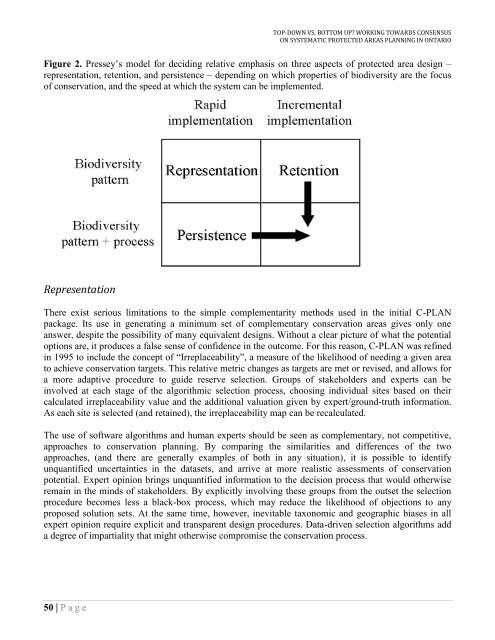Top-Down vs. Bottom Up: Working Towards Consensus ... - CASIOPA
Top-Down vs. Bottom Up: Working Towards Consensus ... - CASIOPA
Top-Down vs. Bottom Up: Working Towards Consensus ... - CASIOPA
- No tags were found...
You also want an ePaper? Increase the reach of your titles
YUMPU automatically turns print PDFs into web optimized ePapers that Google loves.
TOP-DOWN VS. BOTTOM UP? WORKING TOWARDS CONSENSUSON SYSTEMATIC PROTECTED AREAS PLANNING IN ONTARIOFigure 2. Pressey‟s model for deciding relative emphasis on three aspects of protected area design –representation, retention, and persistence – depending on which properties of biodiversity are the focusof conservation, and the speed at which the system can be implemented.RepresentationThere exist serious limitations to the simple complementarity methods used in the initial C-PLANpackage. Its use in generating a minimum set of complementary conservation areas gives only oneanswer, despite the possibility of many equivalent designs. Without a clear picture of what the potentialoptions are, it produces a false sense of confidence in the outcome. For this reason, C-PLAN was refinedin 1995 to include the concept of “Irreplaceability”, a measure of the likelihood of needing a given areato achieve conservation targets. This relative metric changes as targets are met or revised, and allows fora more adaptive procedure to guide reserve selection. Groups of stakeholders and experts can beinvolved at each stage of the algorithmic selection process, choosing individual sites based on theircalculated irreplaceability value and the additional valuation given by expert/ground-truth information.As each site is selected (and retained), the irreplaceability map can be recalculated.The use of software algorithms and human experts should be seen as complementary, not competitive,approaches to conservation planning. By comparing the similarities and differences of the twoapproaches, (and there are generally examples of both in any situation), it is possible to identifyunquantified uncertainties in the datasets, and arrive at more realistic assessments of conservationpotential. Expert opinion brings unquantified information to the decision process that would otherwiseremain in the minds of stakeholders. By explicitly involving these groups from the outset the selectionprocedure becomes less a black-box process, which may reduce the likelihood of objections to anyproposed solution sets. At the same time, however, inevitable taxonomic and geographic biases in allexpert opinion require explicit and transparent design procedures. Data-driven selection algorithms adda degree of impartiality that might otherwise compromise the conservation process.50 | P a g e


